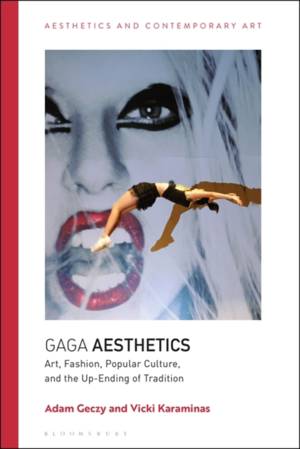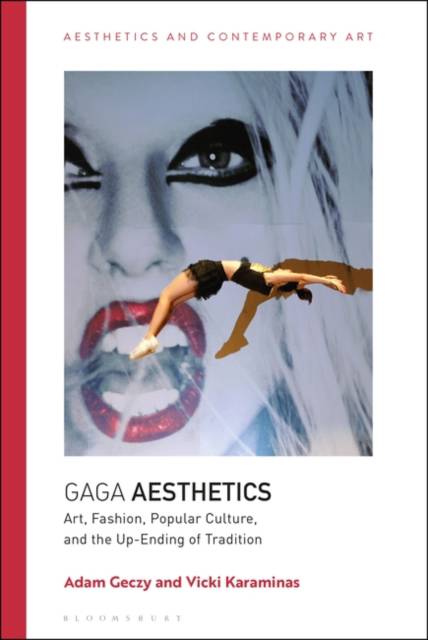
Bedankt voor het vertrouwen het afgelopen jaar! Om jou te bedanken bieden we GRATIS verzending (in België) aan op alles gedurende de hele maand januari.
- Afhalen na 1 uur in een winkel met voorraad
- In januari gratis thuislevering in België
- Ruim aanbod met 7 miljoen producten
Bedankt voor het vertrouwen het afgelopen jaar! Om jou te bedanken bieden we GRATIS verzending (in België) aan op alles gedurende de hele maand januari.
- Afhalen na 1 uur in een winkel met voorraad
- In januari gratis thuislevering in België
- Ruim aanbod met 7 miljoen producten
Zoeken
Gaga Aesthetics
Art, Fashion, Popular Culture, and the Up-Ending of Tradition
Adam Geczy, Vicki Karaminas
€ 67,95
+ 135 punten
Uitvoering
Omschrijving
Pop art has traditionally been the most visible visual art within popular culture because its main transgression is easy to understand: the infiltration of the "low" into the "high". The same cannot be said of contemporary art of the 21st century, where the term "Gaga Aesthetics" characterizes the condition of popular culture being extensively imbricated in high culture, and vice-versa.
Taking Adorno and Horkheimer's "The Culture Industry" and Adorno's Aesthetic Theoryas key touchstones, this book explores the dialectic of high and low that forms the foundation of Adornian aesthetics and the extent to which it still applied, and the extent to which it has radically shifted, thereby 'upending tradition'. In the tradition of philosophical aesthetics that Adorno began with Lukács, this explores the ever-urgent notion that high culture has become deeply enmeshed with popular culture. This is "Gaga Aesthetics" aesthetics that no longer follows clear fields of activity, where "fine art" is but one area of critical activity. Indeed, Adorno's concepts of alienation and the tragic, which inform his reading of the modernist experiment, are now no longer confined to art. Rather, stirring examples can be found in phenomena such as fashion and music video. In addition to dealing with Lady Gaga herself, this book traverses examples ranging from Madonna's Madam X to Moschino and Vetements, to deliberate on the strategies of subversion in the culture industry.
Taking Adorno and Horkheimer's "The Culture Industry" and Adorno's Aesthetic Theoryas key touchstones, this book explores the dialectic of high and low that forms the foundation of Adornian aesthetics and the extent to which it still applied, and the extent to which it has radically shifted, thereby 'upending tradition'. In the tradition of philosophical aesthetics that Adorno began with Lukács, this explores the ever-urgent notion that high culture has become deeply enmeshed with popular culture. This is "Gaga Aesthetics" aesthetics that no longer follows clear fields of activity, where "fine art" is but one area of critical activity. Indeed, Adorno's concepts of alienation and the tragic, which inform his reading of the modernist experiment, are now no longer confined to art. Rather, stirring examples can be found in phenomena such as fashion and music video. In addition to dealing with Lady Gaga herself, this book traverses examples ranging from Madonna's Madam X to Moschino and Vetements, to deliberate on the strategies of subversion in the culture industry.
Specificaties
Betrokkenen
- Auteur(s):
- Uitgeverij:
Inhoud
- Aantal bladzijden:
- 224
- Taal:
- Engels
- Reeks:
Eigenschappen
- Productcode (EAN):
- 9781350272385
- Verschijningsdatum:
- 18/05/2023
- Uitvoering:
- Paperback
- Formaat:
- Trade paperback (VS)
- Afmetingen:
- 156 mm x 234 mm
- Gewicht:
- 312 g

Alleen bij Standaard Boekhandel
+ 135 punten op je klantenkaart van Standaard Boekhandel
Beoordelingen
We publiceren alleen reviews die voldoen aan de voorwaarden voor reviews. Bekijk onze voorwaarden voor reviews.









